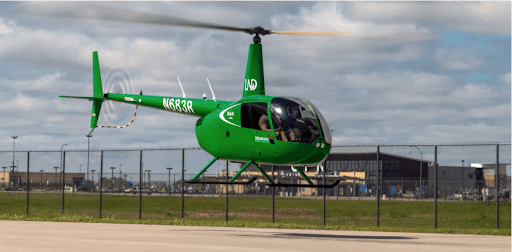Flight schools, large and small, are opting for Robinson Helicopter Company’s R44 Cadet. While suitable for a variety of applications Robinson developed the Cadet with the training market in mind.
For those unfamiliar, the Cadet’s airframe, rotor system, and power plant (Lycoming O-540-F1B5) are the same as Robinson’s proven R44 Raven I. Where the Cadet differs is the rear seats have been removed providing ample cargo space, the maximum gross weight has been reduced to 2200 lb., and the engine power has been derated to 210 hp takeoff and 185 hp continuous. The lower weight and derated power provide increased performance margins at high altitudes, extend the time between overhaul from 2200 hours to 2400 hours. The lower weight also allows for popular options such as air conditioning and Garmin’s large screen G500H 1060 TXi. In addition, the recently certified 4K Ultra HD cockpit camera is an option that can be used as an excellent training aid. Securely mounted in the ceiling for minimal vibration and optimal field of view, the 4K Ultra HD (3840 x 2160 pixels) video camera records video, intercom audio, radio communications, and GPS position to a removable 128 GB USB flash drive. Consumer video editing software can be used to condense cockpit camera video from long flights into short time-lapse videos that can be easily shared with students.
New R44s (including Cadets) also come standard with an engine monitoring unit (EMU) that can be used as a maintenance aid for tracking flight exceedances, also known as “uh oh” events. Robinson Helicopter Company developed an iPad App that only allows pilots/personnel to view data. Operators need not worry about pilots covering up their “mishaps” because resetting of exceedances recorded by the EMU must be performed by a qualified maintenance technician.
Why Choose the R44 Cadet?
When analyzing whether to begin initial flight training in an R44 Cadet or Robinson’s smaller, less expensive R22, CFI and former Robinson Helicopter Company Safety Course instructor, Ken Obi of Orbic Helicopters has a definite opinion. Based in Camarillo, California, Ken Obi has been teaching people how to fly helicopters for over 30 years. Obi has been using Cadets for primary training since he purchased his first one in 2016 (the company will take delivery of its third Cadet this year). He firmly believes the R44 Cadet’s flying characteristics, increased power margins, roomier cabin, and air-conditioning make the learning process significantly easier and more comfortable for students, resulting in faster progression. With fewer hours spent training to achieve proficiency, the cost differential between learning in a Cadet versus an R22 is minimal. The Cadet also has the benefit of giving students experience flying the type of helicopter they’ll most likely rent, purchase, or fly professionally after earning their rating(s). The Cadet offers beginning students a trainer that is appropriate for their skill level. Hydraulic controls provide a stable platform when hovering and increased inertia in the larger rotor system allows for greater reaction time during autorotations.
When looking at the costs associated with training in an R22 versus an R44 Cadet, Obi gave the following example:
Private Rating in R22 – average 65-70 hours to complete ($21,125)
Private Rating in R44 Cadet – average 55-60 hours to complete ($23,650)
With an average cost of $430/hour for the Cadet and an average cost of $325/hour for the Robinson Helicopter Company R22, the cost difference is insignificant compared to the benefits that training in the R44 provides. Once students progress from their private pilot rating to their commercial rating, Obi then introduces them to the R22. Rated pilots can take advantage of the R22’s lower price point to accumulate hours towards their future objectives.
Flight Training Universities
Two prominent aviation universities have procured the R44 Cadet for their training fleets. Southern Utah University (SUU) has purchased seven (in addition to three R44 Raven IIs) and University of North Dakota (UND) has a fleet of five R44 Cadets with a sixth one on order.
When discussing the reasons for their recent fleet replacement, UND’s Director of Flight Operations Dick Shultz explained, “The R44 Cadet is more affordable, has improved maintenance (parts more readily available) and better job opportunities for graduates.” His final and key consideration was for his students, “We want our students to be marketable upon graduation and they need to meet SFAR requirements.” Entry-level flight positions for helicopter pilots (outside of instruction) include but are not limited to, flying tours, photography flights, charter flights, and agricultural operations. Entry level helicopter jobs are primarily flown in the Robinson Helicopter Company R44, motivating students to look for flight schools using the R44.
“In Utah, the Cadet is proving itself at altitude” said Richard Cannon, SUU’s Director of Flight Operations, “we have found the Cadet to be a very safe and capable training aircraft, especially at our altitude (5,846 ft) in Cedar City, Utah. With the advanced avionic options, students receive relevant industry training beginning with their initial flight.”
Since incorporating Robinson Helicopter Company’s Cadet into their respective programs, both universities have seen benefits both operationally and with increased student enrollment.
R44 Cadet – Making Aircraft Ownership a Reality
Private individuals who once thought owning an aircraft was out of reach, have picked up on the Cadet’s low price point. The affordability of the R44 Cadet allowed Ted Krahenbuhl, a long time pilot to purchase his first helicopter. When asked about his experiences, Ted explains he flies his black R44 Cadet, loaded with camping gear, along the Oregon coast which is helicopter paradise. Ted also enjoys camping at the many grass airfields in Oregon.
Mr. Ashley Dickson, Manager of County Helicopters in Australia, uses his Robinson Helicopter Company R44 Cadet primarily for commercial operations. The R44 Cadet is put to use performing ranch work, vineyard frost control, and environmental surveys in the outback of southern Australia. He flies his R44 Cadet an impressive 600 hours per month. “The Cadet is a delightful aircraft to fly and has everything the R22 doesn’t for not much more cost” said Dickson, also noting he has experienced little to no unscheduled maintenance.
Conclusion
Robinson Helicopter Company’s proven track record on customer service and parts availability coupled with the company’s ongoing technological developments make the Cadet suitable for a wide range of applications most notably training.



































